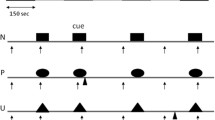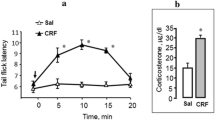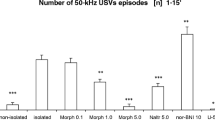Abstract
Rationale
There are inconsistent reports on the effects of cannabinoid agonists on prepulse inhibition of the startle reflex (PPI) with increases, decreases, and no effects. It has been hypothesized that the conflicting observations may be as a result of modulation of the effects of cannabinoid agonists by the regulation of corticosteroid release.
Objective
The purpose of the present study was to determine the effects of CP55940, a cannabinoid agonist, and metyrapone, a corticosteroid synthesis inhibitor on core temperature, motor activity, the startle reflex, and PPI.
Methods
Startle responses were measured in 64 male Wistar rats while varying startling stimulus intensities, analogous to dose–response curves. A stimulus potency measure (ES50) and a response measure, the maximal achievable response (R MAX) were derived from the stimulus–response curves.
Results
CP55940 reduced core temperature and motor activity; these effects were potentiated by metyrapone. CP55940 increased R MAX of startle in the absence of a prepulse by a corticosteroid-dependent mechanism but decreased it when metyrapone was administered before CP55940, a corticosteroid-independent mechanism. The inverse of stimulus potency (ES50) was not affected by either drug alone but was increased by the combined drugs. CP55940 increased the prepulse motor gating effects and decreased the prepulse sensory gating effects of the same prepulses but only when given after metyrapone.
Conclusions
The most parsimonious interpretation of these effects is that CP55940 has some effects through corticosteroid-dependent actions and opposite effects by corticosteroid-independent actions. These two putative sites of actions affect stimulus gating opposite to their effects on response gating.




Similar content being viewed by others
References
Allebeck P, Adamsson C, Engstrom A, Rydberg U (1993) Cannabis and schizophrenia: a longitudinal study of cases treated in Stockholm County. Acta Psychiatr Scand 88:21–24
Andreasson S, Allebeck P, Engstrom A, Rydberg U (1987) Cannabis and schizophrenia. A longitudinal study of Swedish conscripts. Lancet 2:1483–1486
Anguiano B, Valverde C (2001) Cold-induced increment in rat adrenal gland type II deiodinase is corticosterone dependent. Endocrine 15:87–91
Barnes TR, Mutsatsa SH, Hutton SB, Watt HC, Joyce EM (2006) Comorbid substance use and age at onset of schizophrenia. Br J Psychiatry 188:237–242
Black MD, Stevens RJ, Rogacki N, Featherstone RE, Senyah Y, Giardino O, Borowsky B, Stemmelin J, Cohen C, Pichat P, Arad M, Barak S, De Levie A, Weiner I, Griebel G, Varty GB (2011) AVE1625, a cannabinoid CB1 receptor antagonist, as a co-treatment with antipsychotics for schizophrenia: improvement in cognitive function and reduction of antipsychotic-side effects in rodents. Psychopharmacology (Berl) 215:149–163
Bortolato M, Aru GN, Frau R, Orru M, Luckey GC, Boi G, Gessa GL (2005) The CB receptor agonist WIN 55,212-2 fails to elicit disruption of prepulse inhibition of the startle in Sprague-Dawley rats. Psychopharmacology (Berl) 177:264–271
Bortolato M, Campolongo P, Mangieri RA, Scattoni ML, Frau R, Trezza V, La Rana G, Russo R, Calignano A, Gessa GL, Cuomo V, Piomelli D (2006a) Anxiolytic-like properties of the anandamide transport inhibitor AM404. Neuropsychopharmacology 31:2652–2659
Bortolato M, Frau R, Orru M, Casti A, Aru GN, Fa M, Manunta M, Usai A, Mereu G, Gessa GL (2006b) Prenatal exposure to a cannabinoid receptor agonist does not affect sensorimotor gating in rats. Eur J Pharmacol 531:166–170
Braff D, Stone C, Callaway E, Geyer M, Glick I, Bali L (1978) Prestimulus effects on human startle reflex in normals and schizophrenics. Psychophysiology 15:339–343
Brown TT, Dobs AS (2002) Endocrine effects of marijuana. J Clin Pharmacol 42:90S–96S
Buwalda B, de Boer SF, Van Kalkeren AA, Koolhaas JM (1997) Physiological and behavioral effects of chronic intracerebroventricular infusion of corticotropin-releasing factor in the rat. Psychoneuroendocrinology 22:297–309
Cheer JF, Wassum KM, Heien ML, Phillips PE, Wightman RM (2004) Cannabinoids enhance subsecond dopamine release in the nucleus accumbens of awake rats. J Neurosci 24:4393–4400
Compton DR, Aceto MD, Lowe J, Martin BR (1996) In vivo characterization of a specific cannabinoid receptor antagonist (SR141716A): inhibition of delta 9-tetrahydrocannabinol-induced responses and apparent agonist activity. J Pharmacol Exp Ther 277:586–594
Corchero J, Fuentes JA, Manzanares J (1999) Chronic treatment with CP-55,940 regulates corticotropin releasing factor and proopiomelanocortin gene expression in the hypothalamus and pituitary gland of the rat. Life Sci 64:905–911
Curzon P, Decker MW (1998) Effects of phencyclidine (PCP) and (+)MK-801 on sensorimotor gating in CD-1 mice. Prog Neuropsychopharmacol Biol Psychiatry 22:129–146
Czyrak A, Mackowiak M, Chocyk A, Fijal K, Gadek-Michalska A, Wedzony K (2003) 8-OHDPAT-induced disruption of prepulse inhibition in rats is attenuated by prolonged corticosterone treatment. Neuropsychopharmacology 28:1300–1310
Dean B, Bradbury R, Copolov DL (2003) Cannabis-sensitive dopaminergic markers in postmortem central nervous system: changes in schizophrenia. Biol Psychiatry 53:585–592
Fregly MJ (1960) Interaction of adrenals and thyroid in maintenance of body temperature of rats exposed to cold. Am J Physiol 199:437–444
Frisher M, Crome I, Macleod J, Millson D, Croft P (2005) Substance misuse and psychiatric illness: prospective observational study using the general practice research database. J Epidemiol Community Health 59:847–850
Fritzsche M (2001) Are cannabinoid receptor knockout mice animal models for schizophrenia? Med Hypotheses 56:638–643
Gallistel CR, Freyd G (1987) Quantitative determination of the effects of catecholaminergic agonists and antagonists on the rewarding efficacy of brain stimulation. Pharmacol Biochem Behav 26:731–741
Gonzalez S, Bisogno T, Wenger T, Manzanares J, Milone A, Berrendero F, Di Marzo V, Ramos JA, Fernandez-Ruiz JJ (2000) Sex steroid influence on cannabinoid CB(1) receptor mRNA and endocannabinoid levels in the anterior pituitary gland. Biochem Biophys Res Commun 270:260–266
Gonzalez S, Manzanares J, Berrendero F, Wenger T, Corchero J, Bisogno T, Romero J, Fuentes JA, Di Marzo V, Ramos JA, Fernandez-Ruiz J (1999) Identification of endocannabinoids and cannabinoid CB(1) receptor mRNA in the pituitary gland. Neuroendocrinology 70:137–145
Green MF, Satz P, Smith C, Nelson L (1989) Is there atypical handedness in schizophrenia? J Abnorm Psychol 98:57–61
Grillon C (2002) Startle reactivity and anxiety disorders: aversive conditioning, context, and neurobiology. Biol Psychiatry 52:958–975
Gupta S, Hendricks S, Kenkel AM, Bhatia SC, Haffke EA (1996) Relapse in schizophrenia: is there a relationship to substance abuse? Schizophr Res 20:153–156
Hall W, Solowij N (1997) Long-term cannabis use and mental health. Br J Psychiatry 171:107–108
Healy DG, Harkin A, Cryan JF, Kelly JP, Leonard BE (1999) Metyrapone displays antidepressant-like properties in preclinical paradigms. Psychopharmacology (Berl) 145:303–308
Hince DA, Martin-Iverson MT (2005) Differences in prepulse inhibition (PPI) between Wistar and Sprague-Dawley rats clarified by a new method of PPI standardization. Behav Neurosci 119:66–77
Ingram N, Martin S, Wang JH, van der Laan S, Loiacono R, van den Buuse M (2005) Interaction of corticosterone and nicotine in regulation of prepulse inhibition in mice. Neuropharmacology 48:80–92
Jablensky A, McGrath J, Herrman H, Castle C, Gureje O, Morgan V (1999) National Survey of Mental Health and Wellbeing Report 4. People living with psychotic illness: an Australian study 1997–98. IN. National Mental Health Strategy, Australia: 103
Johnson KM, Dewey WL, Ritter KS, Beckner JS (1978) Cannabinoid effects on plasma corticosterone and uptake of 3H-corticosterone by mouse brain. Eur J Pharmacol 47:303–310
Jones P, Murray RM (1991) The genetics of schizophrenia is the genetics of neurodevelopment. Br J Psychiatry 158:615–623
Kedzior KK, Martin-Iverson MT (2006) Chronic cannabis use is associated with attention-modulated reduction in prepulse inhibition of the startle reflex in healthy humans. J Psychopharmacol 20:471–484
Kedzior KK, Martin-Iverson MT (2007) Attention-dependent reduction in prepulse inhibition of the startle reflex in cannabis users and schizophrenia patients—a pilot study. Eur J Pharmacol 560:176–182
Long LE, Malone DT, Taylor DA (2006) Cannabidiol reverses MK-801-induced disruption of prepulse inhibition in mice. Neuropsychopharmacology 31:795–803
Mansbach RS, Geyer MA, Braff DL (1988) Dopaminergic stimulation disrupts sensorimotor gating in the rat. Psychopharmacology (Berl) 94:507–514
Mansbach RS, Rovetti CC, Winston EN, Lowe JA 3rd (1996) Effects of the cannabinoid CB1 receptor antagonist SR141716A on the behavior of pigeons and rats. Psychopharmacology (Berl) 124:315–322
Manzanares J, Corchero J, Fuentes JA (1999) Opioid and cannabinoid receptor-mediated regulation of the increase in adrenocorticotropin hormone and corticosterone plasma concentrations induced by central administration of delta(9)-tetrahydrocannabinol in rats. Brain Res 839:173–179
Martin-Calderon JL, Munoz RM, Villanua MA, del Arco I, Moreno JL, de Fonseca FR, Navarro M (1998) Characterization of the acute endocrine actions of (−)-11-hydroxy-delta8-tetrahydrocannabinol-dimethylheptyl (HU-210), a potent synthetic cannabinoid in rats. Eur J Pharmacol 344:77–86
Martin-Iverson MT, Stevenson KN (2005) Apomorphine effects on emotional modulation of the startle reflex in rats. Psychopharmacology (Berl) 181:60–70
Martin RS, Secchi RL, Sung E, Lemaire M, Bonhaus DW, Hedley LR, Lowe DA (2003) Effects of cannabinoid receptor ligands on psychosis-relevant behavior models in the rat. Psychopharmacology (Berl) 165:128–135
Meloni EG, Gerety LP, Knoll AT, Cohen BM, Carlezon WA Jr (2006) Behavioral and anatomical interactions between dopamine and corticotropin-releasing factor in the rat. J Neurosci 26:3855–3863
Miller AS, Sanudo-Pena MC, Walker JM (1998) Ipsilateral turning behavior induced by unilateral microinjections of a cannabinoid into the rat subthalamic nucleus. Brain Res 793:7–11
Moore TH, Zammit S, Lingford-Hughes A, Barnes TR, Jones PB, Burke M, Lewis G (2007) Cannabis use and risk of psychotic or affective mental health outcomes: a systematic review. Lancet 370:319–328
Murphy LL, Munoz RM, Adrian BA, Villanua MA (1998) Function of cannabinoid receptors in the neuroendocrine regulation of hormone secretion. Neurobiol Dis 5:432–446
Murray RM, Jones P, O'Callaghan E (1991) Fetal brain development and later schizophrenia. CIBA Found Symp 156:155–163, discussion 163–70
Nagai H, Egashira N, Sano K, Ogata A, Mizuki A, Mishima K, Iwasaki K, Shoyama Y, Nishimura R, Fujiwara M (2006) Antipsychotics improve Delta9-tetrahydrocannabinol-induced impairment of the prepulse inhibition of the startle reflex in mice. Pharmacol Biochem Behav 84:330–336
Piazza PV, Rouge-Pont F, Deroche V, Maccari S, Simon H, Le Moal M (1996) Glucocorticoids have state-dependent stimulant effects on the mesencephalic dopaminergic transmission. Proc Natl Acad Sci U S A 93:8716–8720
Pryce CR, Bettschen D, Bahr NI, Feldon J (2001) Comparison of the effects of infant handling, isolation, and nonhandling on acoustic startle, prepulse inhibition, locomotion, and HPA activity in the adult rat. Behav Neurosci 115:71–83
Quednow BB, Kuhn KU, Hoenig K, Maier W, Wagner M (2004) Prepulse inhibition and habituation of acoustic startle response in male MDMA ('ecstasy') users, cannabis users, and healthy controls. Neuropsychopharmacology 29:982–990
Rawls SM, Cabassa J, Geller EB, Adler MW (2002) CB1 receptors in the preoptic anterior hypothalamus regulate WIN 55212–2 [(4,5-dihydro-2-methyl-4(4-morpholinylmethyl)-1-(1-naphthalenyl-carbonyl)- 6H-pyrrolo[3,2,1ij]quinolin-6-one]-induced hypothermia. J Pharmacol Exp Ther 301:963–968
Rawls SM, Tallarida RJ, Kon DA, Geller EB, Adler MW (2004) GABAA receptors modulate cannabinoid-evoked hypothermia. Pharmacol Biochem Behav 78:83–91
Risbrough VB, Hauger RL, Roberts AL, Vale WW, Geyer MA (2004) Corticotropin-releasing factor receptors CRF1 and CRF2 exert both additive and opposing influences on defensive startle behavior. J Neurosci 24:6545–6552
Schneider M, Koch M (2002) The cannabinoid agonist WIN 55,212-2 reducessensorimotor gating and recognition memory in rats. Behav Pharmacol 13:29–37
Schneider M, Koch M (2003) Chronic pubertal, but not adult chronic cannabinoid treatment impairs sensorimotor gating, recognition memory, and the performance in a progressive ratio task in adult rats. Neuropsychopharmacology 28:1760–1769
Scholes KE, Martin-Iverson MT (2009) Alterations to pre-pulse inhibition (PPI) in chronic cannabis users are secondary to sustained attention deficits. Psychopharmacology (Berl) 207:469–484
Scholes KE, Martin-Iverson MT (2010) Disturbed prepulse inhibition in patients with schizophrenia is consequential to dysfunction of selective attention. Psychophysiology 47:223–235
Solowij N, Michie PT (2007) Cannabis and cognitive dysfunction: parallels with endophenotypes of schizophrenia? J Psychiatry Neurosci 32:30–52
Stanley-Cary CC, Harris C, Martin-Iverson MT (2002) Differing effects of the cannabinoid agonist, CP 55,940, in an alcohol or Tween 80 solvent, on prepulse inhibition of the acoustic startle reflex in the rat. Behav Pharmacol 13:15–28
Stevens KE, Bullock AE, Collins AC (2001) Chronic corticosterone treatment alters sensory gating in C3H mice. Pharmacol Biochem Behav 69:359–366
Stoddart CW, Noonan J, Martin-Iverson MT (2008) Stimulus quality affects expression of the acoustic startle response and prepulse inhibition in mice. Behav Neurosci 122:516–526
Strube MJ, Bobko P (1989) Testing hypotheses about ordinal interactions: simulations and further comments. J Appl Psychol 74:247–252
Swerdlow NR, Eastvold A, Karban B, Ploum Y, Stephany N, Geyer MA, Cadenhead K, Auerbach PP (2002) Dopamine agonist effects on startle and sensorimotor gating in normal male subjects: time course studies. Psychopharmacology (Berl) 161:189–201
Swerdlow NR, Stephany N, Wasserman LC, Talledo J, Shoemaker J, Auerbach PP (2003) Amphetamine effects on prepulse inhibition across-species: replication and parametric extension. Neuropsychopharmacology 28:640–650
van den Buuse M, Morris M, Chavez C, Martin S, Wang J (2004) Effect of adrenalectomy and corticosterone replacement on prepulse inhibition and locomotor activity in mice. Br J Pharmacol 142:543–550
van Os J, Bak M, Hanssen M, Bijl RV, de Graaf R, Verdoux H (2002) Cannabis use and psychosis: a longitudinal population-based study. Am J Epidemiol 156:319–327
Verdoux H, Sorbara F, Gindre C, Swendsen JD, van Os J (2003) Cannabis use and dimensions of psychosis in a nonclinical population of female subjects. Schizophr Res 59:77–84
Waddington JL, Torrey EF, Crow TJ, Hirsch SR (1991) Schizophrenia, neurodevelopment, and disease. The Fifth Biannual Winter Workshop on Schizophrenia, Badgastein, Austria, January 28 to February 3, 1990. Arch Gen Psychiatry 48:271–273
Weidenfeld J, Feldman S, Mechoulam R (1994) Effect of the brain constituent anandamide, a cannabinoid receptor agonist, on the hypothalamo-pituitary-adrenal axis in the rat. Neuroendocrinology 59:110–112
Weiser M, Noy S (2005) Interpreting the association between cannabis use and increased risk for schizophrenia. Dialogues Clin Neurosci 7:81–85
Wenger T, Jamali KA, Juaneda C, Leonardelli J, Tramu G (1997) Arachidonyl ethanolamide (anandamide) activates the parvocellular part of hypothalamic paraventricular nucleus. Biochem Biophys Res Commun 237:724–728
Zammit S, Allebeck P, Andreasson S, Lundberg I, Lewis G (2002) Self reported cannabis use as a risk factor for schizophrenia in Swedish conscripts of 1969: historical cohort study. BMJ 325:1199
Zuardi AW, Crippa JA, Hallak JE, Moreira FA, Guimaraes FS (2006) Cannabidiol, a Cannabis sativa constituent, as an antipsychotic drug. Braz J Med Biol Res 39:421–429
Acknowledgements
We thank NHMRC and Western Australian Institute for Medical Research (WAIMR) for their generous support of this research.
Author information
Authors and Affiliations
Corresponding author
Rights and permissions
About this article
Cite this article
Avdesh, A., Cornelisse, V. & Martin-Iverson, M.T. Corticosteroid dependent and independent effects of a cannabinoid agonist on core temperature, motor activity, and prepulse inhibition of the acoustic startle reflex in Wistar rats. Psychopharmacology 220, 405–415 (2012). https://doi.org/10.1007/s00213-011-2493-z
Received:
Accepted:
Published:
Issue Date:
DOI: https://doi.org/10.1007/s00213-011-2493-z




